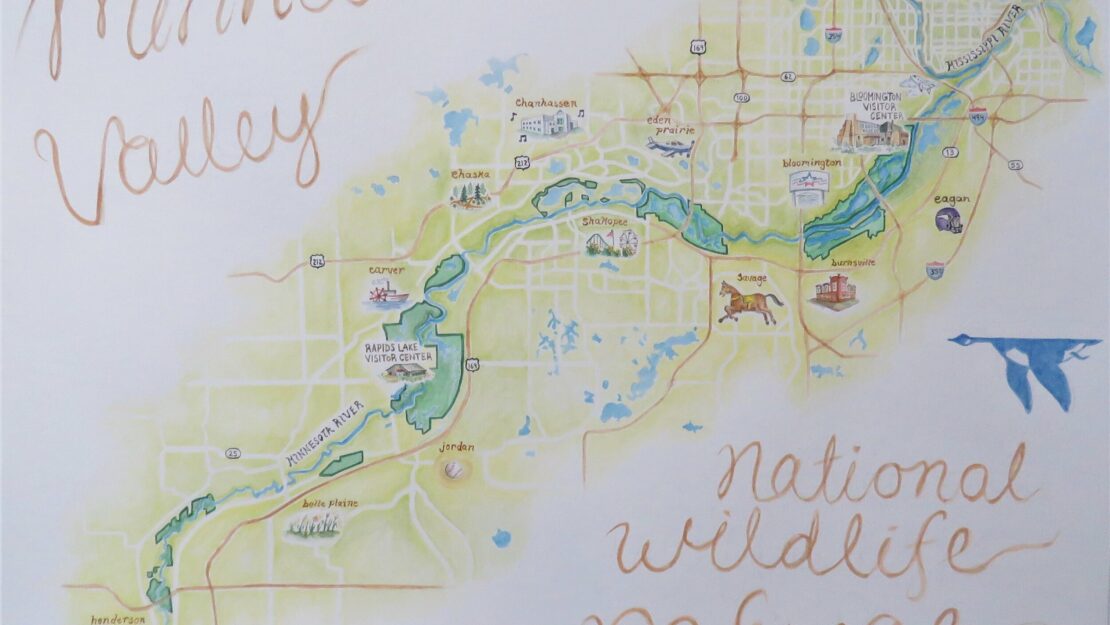A service term is just a trailer for the movie

by Gina Hatch, visitor services intern/ AmeriCorps member with Minnesota Valley National Wildlife Refuge through Conservation Corps’ Individual Placement program

The video features a watercolor map of the refuge that I created with the goal of informing visitors (out-of-towners especially) a little bit more about our geographic context and what our surrounding communities have to offer.
With my second year as an Individual Placement at Minnesota Valley National Wildlife Refuge drawing to a close, I’ve finally polished off the largest singular project of my service term: an eight-minute video introducing the refuge and explaining what it’s all about. The video is an upbeat synopsis of Minnesota Valley, intended to show visitors a little bit of everything we have to offer. And so it feels like a fitting project to reflect on as I take stock of my time at the refuge as a whole and the variety of experiences I’ve had there.
The video lays out the basics of the refuge in careful, intentional order. Before defining what a wildlife refuge is or even mentioning the US Fish and Wildlife Service, it starts off setting the refuge’s geographic scene: Minnesota Valley is an urban wilderness, situated right next door to 3.5 million residents of the Twin Cities metro area. After a couple shots of Minneapolis’s gleaming skyline and the refuge’s light rail station, the viewer is suddenly immersed in Minnesota Valley’s green trails and expansive river views. These views then give way to close-ups with the creatures that populate this wild expanse: preening mallards, twittering nuthatches and chattering cardinals, stoic green leopard frogs, trotting turkeys, grazing deer, nectaring bees and delicate monarchs. And then come the people. Walking, hiking, bird watching, fishing, biking, gathering, meeting, teaching, learning, crafting. Together the refuge’s diverse visitors and supporters build a vibrant community where nature, culture, art, and education all flourish. A cinematic swell builds around footage of parade participants at our annual EcoArts Festival.
The second half of the video becomes more informational. The voiceover explains why the refuge was founded, the importance of the Minnesota River Valley, the work that Fish and Wildlife Service staff do to protect the land and its ecosystems, and the unique place Minnesota Valley holds amid the nation’s vast network of wildlife refuges. The camera strings together scenes of our many different teams at work on and around the refuge: biology, maintenance, urban outreach, education, visitor services, and others. And the numerous staff, volunteers, and interns who make up these industrious teams. Then, to conclude things, we land back on footage of visitors at our festivals and events–because the purpose of all the work we do is to create a welcoming and thriving place for the public. “Minnesota Valley National Wildlife Refuge belongs to you, so get out and explore!”
The arc of the video is probably not too different from my own process of getting to know the refuge. I started out largely unfamiliar with the Fish and Wildlife Service but thrilled that I was getting the chance to work at an awesomely wild place so close to my urban home. For my first few weeks as a Visitor Services Intern, the most pressing task at hand for me was to get to know the place physically–the river, the plants, the animals–so that I could be a helpful guide to our visitors.
From there, my understanding of where I was continued to expand outwards. In working daily with our visitors and our volunteers, I got to know much more about our surrounding communities–the dynamics between our urban and rural audiences, who was showing up and who wasn’t and why or why not. The more I got to work with other staff and the more meetings and trainings I took part in, the more I came to understand what the Fish and Wildlife Service stands for and what makes a national wildlife refuge distinct and important. I gained more and more appreciation for the role of each staff member, from our urban biologist to our law enforcement officer, in making the refuge complete. As I met Service employees from other regions, my scope grew beyond Minnesota Valley and the network of refuges around the rest of the country started to seem much more real and material to me. So too, did the notion that we were serving some kind of unified entity referred to in our mission as “the American public.”
As in the video, I shifted from a focus on the immediate wonders that met my senses, to an awareness of the broader picture I was a part of and why it is so special. Eight minutes is hardly enough to make this journey cinematically, and similarly, two years has felt like hardly enough time to make this journey experientially. But the purpose of the video is ultimately just to be a trailer for all there is to experience at the refuge and to leave visitors excited to explore more. Looking at my service with that same measure of success in mind, I can only be pleased and grateful. My time at Minnesota Valley has opened my eyes to the world of work that I love doing, to a mountain of questions I’m jumping to get answered, and to a labyrinth of paths I’m eager to explore.